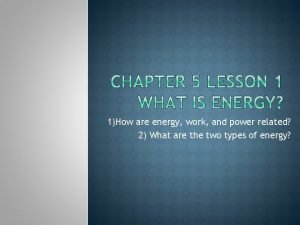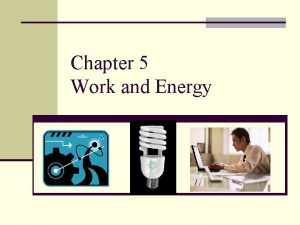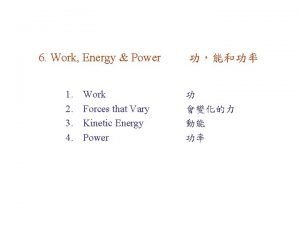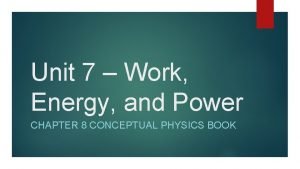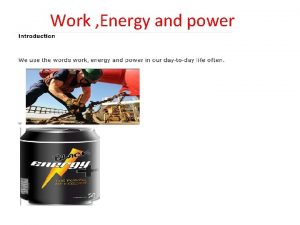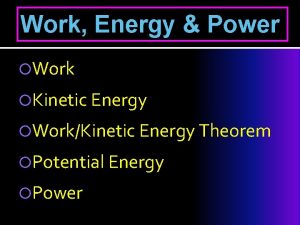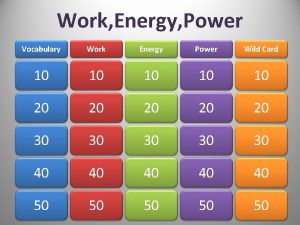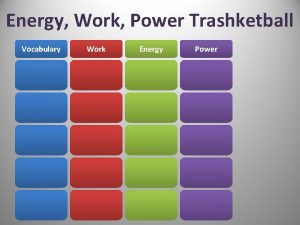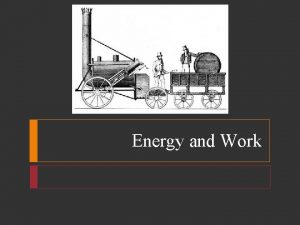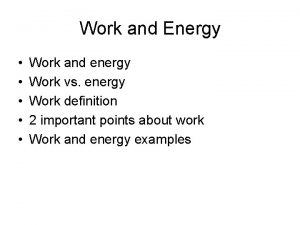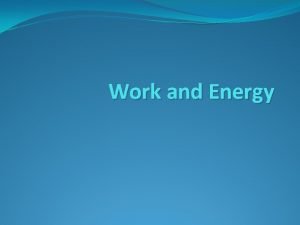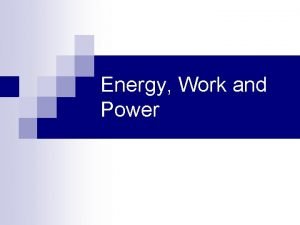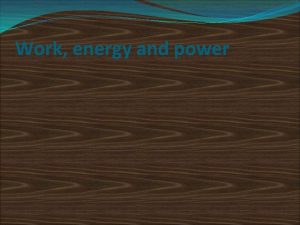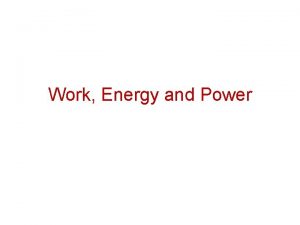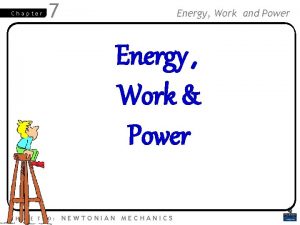PHYS 16 Lecture 16 Work Energy and Power















- Slides: 15

PHYS 16 – Lecture 16 Work, Energy, and Power October 15, 2010

This Week… • What is Energy? What is Work? • Work-Energy Theorem – how energy and work are related • What is Power?

Definition of Work • Mechanical Work (W) – energy transferred to an object due to the action of a force (+) transfer to object (-) transfer from object

Work with a Constant Force • Force = Constant, then can take force outside integral

Practice Question • I pull a 4. 0 kg sled a distance of 5. 0 m. I pull the sled using a rope at a 30. 0 degree angle with a force of 5. 0 N. What is the work done by me? A) 0 J B) 20 J C) 25 J D) 22 J

Work with a Variable Force Fx • Force = Constant, then can take force outside integral x

Practice Question • A force is given by Fx = 3 x 2+2. What is the work done by the force for moving an object from x=0. 0 m to x=4. 0 m? A) 72 J B) 50 J C) 0 J D) 200 J

Work – Energy Theorem • Work = the transfer of Energy • Energy = the ability to do work Work done by External Force Change in Energy to the system

Work and grav. potential energy • If I lift an object, how much work did I do on the object? • Use work-energy theorem to derive gravitational potential energy Force and displacement are both downward

Work and spring potential energy • If mass on a spring moves, how much work is done by spring? • Use work-energy theorem to derive spring potential energy Work done by system is negative Force and displacement are in opposite directions

Work and Kinetic energy • If an object speeds up, how much work is done on object? • Use work-energy theorem to derive kinetic energy Assume K=mv 2/2 and prove left side = right side Just multiply and divide by dt since dt/dt=1 Now take derivative and remember to use chain rule

Let’s define Power • Power – the rate at which work is performed – Units = W = J/s – Scalar

Lingenfelter Corvette… • What is the power of the 1420 kg Lingenfelter Corvette that can go 0 to 26. 8 m/s in 1. 97 s? Approach #1 Approach #2 Answer = 259 k. W Spec says 1100 k. W, why?

Horsepower • 1 hp = 33, 000 ft lbs/min • Comes from how much weight a horse could pull up a mine shaft a particular amount of feet in a given minute Horse Force

Estimating horsepower • Car = 250 -1475 hp – 1 hp = 746 W – Lingenfelter corvette = 1475 hp – Small compact= 250 hp • Lawnmower = 5 -25 hp • Person = ~1 hp – Estimate using time it takes to run up stairs
 Phys 241 purdue
Phys 241 purdue Chapter 4 section 1 work and machines answer key
Chapter 4 section 1 work and machines answer key 01:640:244 lecture notes - lecture 15: plat, idah, farad
01:640:244 lecture notes - lecture 15: plat, idah, farad Work, power and energy activities
Work, power and energy activities Work done define
Work done define How are energy work and power related
How are energy work and power related Work power energy and machines
Work power energy and machines F d cos theta
F d cos theta Work power
Work power Unit 7 work energy and power answers
Unit 7 work energy and power answers Physics 03-06 impulse and momentum answer key
Physics 03-06 impulse and momentum answer key Work and energy section 2 describing energy
Work and energy section 2 describing energy Draw power triangle
Draw power triangle Energy energy transfer and general energy analysis
Energy energy transfer and general energy analysis Energy energy transfer and general energy analysis
Energy energy transfer and general energy analysis Regents physics work power energy
Regents physics work power energy





